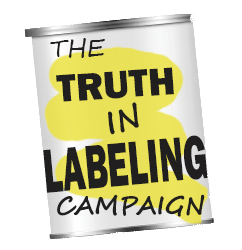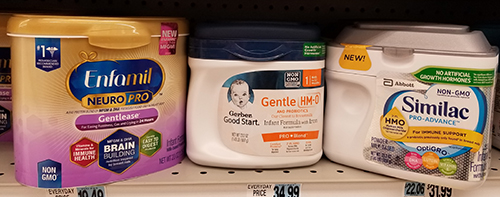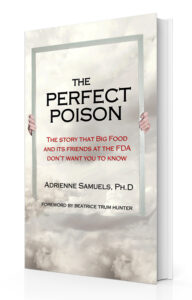In 1969 the moms and dads of America were promised by the top three baby-food manufacturers that monosodium glutamate would be taken out of their products.
Sure, the baby food executives whined and complained and told how the public had been “unnecessarily alarmed and confused,” but they had hit a brick wall. Dr. John Olney, a top researcher at the Washington University School of Medicine in St. Louis, had recently published data showing that when newborn mice were exposed to the additive, they suffered extensive brain damage and endocrine disorders, and he coined the term “excitotoxin” to describe monosodium glutamate. As the late Dr. Jean Mayer, a highly respected nutritionist who taught at Harvard for 25 years (and went on to be named president of Tufts University), said at the time: “I would take the damn stuff out of baby food.”
But half a century later, that “damn stuff” is still being fed to babies – only now added to infant formula.
A formula for disaster
Asked to report on the use of toxic free glutamate in infant formula, we were appalled by the many articles available online that talked of the pros and cons of using various brands, but never once mentioned the presence of excitotoxins.
While monosodium glutamate may have been removed from those little jars of baby food, the same excitotoxic glutamic acid found in monosodium glutamate, now in ingredients such as whey protein concentrate and soy protein isolate, began appearing in infant formula. One product made by Enfamil shockingly lists among its ingredients monosodium glutamate, advising caregivers that it can be continued on as a “milk substitute in the diet of children.”
There are a variety of ways free glutamate harms the body. When Olney testified in 1972 before the Senate Select Committee on Nutrition and Human Needs, he was attesting to the brain damage and subsequent endocrine disorders caused by the free glutamate in monosodium glutamate when fed to the very young.
Now, people realize that monosodium glutamate also causes adverse reactions such as asthma, migraine headache, irritable bowel, skin rash, seizures, and heart irregularities.
But along the way to this enlightenment, the link between free glutamate and brain damage seems to have been forgotten. Perhaps that’s because you can’t see brain damage with the naked eye. There’s no pain, no upset stomach, no itching or wheezing.
And stealthily, the glutamate industry has invested millions of dollars in propaganda intended to reassure the public that monosodium glutamate is merely a harmless food additive.
It’s not that health authorities don’t seem to care what’s in infant formulas. The public has been alerted to various toxic ingredients that have been found in these products over the years, including melamine (a compound used to make plastics) and perchlorate (a chemical found in rocket fuel). In fact, the plastic additive BPA has been banned from baby bottles.
But there’s no warning about excitotoxins.
That’s why if you’re thinking of using – or currently use — infant formula, it’s essential that you read the ingredients. Think carefully about the chemicals that are commonly used in these products and beware of hidden excitotoxins.
In March, 2019, we found the following 10 brands of infant formula listed at Amazon.com and searched out their ingredients. These included:
- Enfamil,
- Similac,
- Earth’s Best,
- Kirkland Signature
- Good Start
- Happy Baby
- Good Sense
- Member’s Mark
- Plum Organics
- Parent’s Choice
In the following ingredient lists, excitotoxic ingredients are highlighted. Only ones that make up more than 1 or 2 percent of the product are included.
Note: The excitotoxin content of milk depends on whether or not whole milk is used in the milk product. If whole milk is used, the excitotoxin content of the milk depends on the pasteurization process (higher heat for longer time frees more glutamic acid and aspartic acid from the original milk protein). If low fat or non-fat milks are used, there will be excitotoxin in the low fat and non-fat milk because those milks are made from milk powder which contains free glutamic acid and free aspartic acid as unavoidable consequences of manufacture.
Enfamil PREMIUM Infant Formula, Powder
NONFAT MILK, LACTOSE, VEGETABLE OIL (PALM OLEIN, COCONUT, SOY, AND HIGH OLEIC SUNFLOWER OILS), WHEY PROTEIN CONCENTRATE…
Similac Advance
Nonfat Milk, Lactose, Whey Protein Concentrate, High Oleic Safflower Oil, Soy Oil, Coconut Oil, Galactooligosaccharides…
Earth’s Best Organic Dairy Infant Formula with Iron
Organic Lactose, Organic Nonfat Milk, Organic Oils (Organic Palm or Palm Olein, Organic Soy, Organic Coconut, Organic High Oleic Safflower or Sunflower Oil), Organic Whey Protein Concentrate…
Kirkland Signature Infant Formula
Nonfat milk, lactose, whey protein concentrate, high oleic safflower oil, soy oil, coconut oil, galacto-oligosaccharides…
Gerber Good Start non-GMO powder Infant Formula
WHEY PROTEIN CONCENTRATE (FROM COW\’S MILK, ENZYMATICALLY HYDROLYZED, REDUCED IN MINERALS), vegetable oils (, PALM OLEIN, SOY, COCONUT, AND , HIGH-OLEIC SAFFLOWER, OR , HIGH-OLEIC SUNFLOWER) , LACTOSE, CORN MALTODEXTRIN…
Happy Baby Organic Stage 1 Infant Formula Milk Based Powder with Iron
Organic non-fat milk, organic whey protein concentrate…
Good Sense
Corn syrup, non-fat milk, whey protein hydrolysate…
Member’s Mark
NONFAT MILK, LACTOSE, VEGETABLE OILS (PALM OLEIN, COCONUT, SOY, HIGH OLEIC [SAFFLOWER OR SUNFLOWER] OIL), WHEY PROTEIN CONCENTRATE, GALACTOOLIGOSACCHARIDES‡…
Plum Organics
Organic Nonfat Milk….Organic Whey Protein Concentrate…
Parent’s Choice Non-GMO Premium Infant Formula with Iron
Nonfat Milk, Lactose, Vegetable Oils (Palm Olein, Coconut, Soy, High Oleic (Safflower Or Sunflower] Oil), Whey Protein Concentrate, Galactooligosaccharides…
However, infant formula isn’t the only way a baby can be exposed to free glutamate.
The bizarre connection between Big Food and breast milk
Research done in the 1980s and 1990s confirmed that monosodium glutamate and other ingredients that contain free glutamate are passed by pregnant women to their fetuses, and by lactating mothers to their newborns. Studies found that free glutamate can cross the placenta during pregnancy, can cross the blood brain barrier (BBB) in an unregulated manner during development, and can pass through the five circumventricular organs that lie outside the BBB.
In the 1960s and 1970s Olney described the brain damage done by monosodium glutamate, which was found to destroy brain cells when fed in large quantity to animals whose brains were not protected by blood brain barriers. Olney observed that the BBBs of fetuses and newborns seen in the laboratory left certain areas of their developing brains unprotected, and he cautioned that human fetuses and newborns were similarly at risk. The unprotected areas included the arcuate nucleus of the hypothalamus, the area of the brain that, when undamaged, regulates reproduction and weight (telling us when to stop eating).
Every woman who breast feeds her baby will want to make sure that her diet does not contain excitotoxins – or contains as few as possible. That list includes aspartic acid (found in aspartame, e.g., Nutrasweet, Equal, Amino Sweet, and other aspartame-based sugar substitutes); L-cysteine, found in dough conditioners, and the many ingredients that contain free glutamate.
Certainly, every parent wants a healthy baby, but there are industry giants out there who only care about their bottom lines. Consumer beware.











